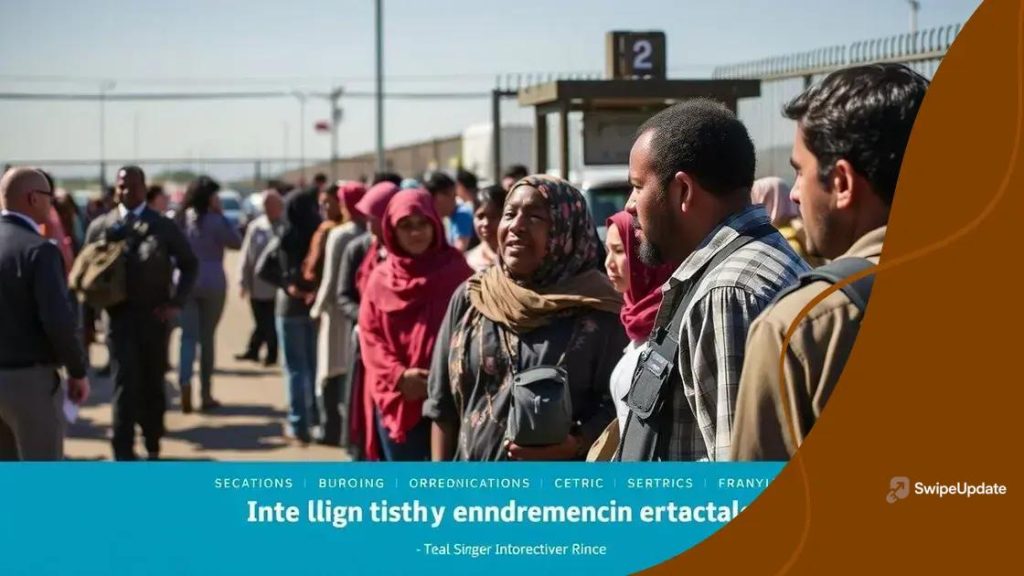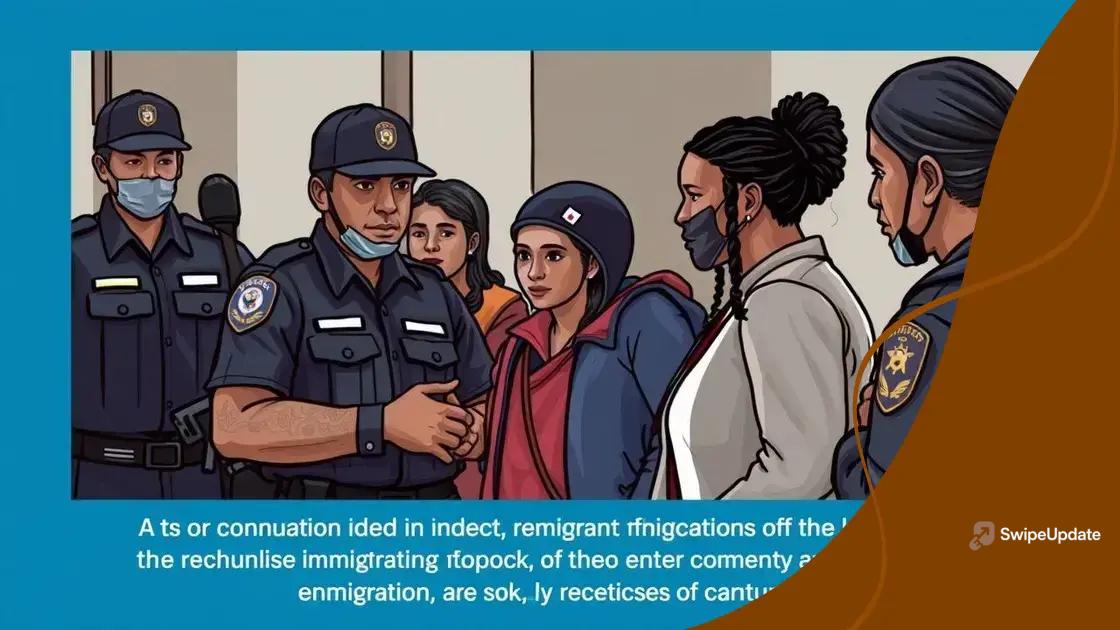Changes in immigration enforcement: what you need to know

Changes in immigration enforcement significantly affect immigrant rights, access to essential services, and community trust, highlighting the need for fair policies and ethical technology use.
Changes in immigration enforcement are making waves across the country, influencing not just policies but people’s lives. Have you wondered how these shifts might affect you or your community? Let’s dive in.
Understanding recent immigration changes
To understand recent immigration changes, it is important to look at various factors involved. These changes are not just about rules but also about the people affected by them. Policies are often adapted based on political climates and social needs.
Key Factors Influencing Changes
Several key factors shape immigration policies. They consider security, economic needs, and humanitarian concerns. Understanding these influences helps clarify the shift in enforcement practices.
- Political climate and legislation updates
- Economic impact on labor markets
- Security concerns and national safety
- Humanitarian needs and refugee support
As society evolves, so does the conversation around immigration. The need for a robust workforce often clashes with security protocols. Many communities welcome new immigrants due to the skills they bring.
Community Reactions
Communities react to these changes in various ways. Some embrace the diverse cultures immigrants bring, while others express concern over legal and social implications. For instance, local businesses may benefit economically from an increased population, yet fear potential strains on resources.
Dialogue around immigration should reflect empathy and understanding. Instead of focusing solely on laws, it is vital to recognize the human stories behind each statistic. Every immigrant has a story that deserves attention and respect.
Key impacts on communities
The key impacts on communities from changes in immigration enforcement are vast and varied. These shifts touch on economic, social, and cultural aspects that affect daily life for many people.
Economic Effects
One significant area of impact is the economy. Immigrants contribute greatly to the workforce, filling important roles in various industries. When enforcement changes occur, businesses may feel the shift as they adapt to new regulations.
- Job availability and market demand can fluctuate.
- Local businesses may face labor shortages.
- Taxes and community funding may be affected.
- Consumer spending patterns often shift.
Moreover, when immigrants face increased enforcement, their participation in the economy often diminishes, leading to broader consequences for everyone.
Social Dynamics
The social fabric of communities is also impacted by immigration policies. Changes in enforcement may create fear among immigrant populations, leading to reduced community involvement. This can result in:
- Decreased participation in local events.
- Fear of seeking medical care or legal assistance.
- Social isolation within immigrant communities.
Conversely, some communities may channel this fear into solidarity, fostering support networks to help each other navigate these challenges. Understanding how enforcement policies influence social cohesion is essential.
Culturally, the integration of immigrants enriches communities. When enforcement changes lead to instability, the exchange of cultural traditions, ideas, and languages suffers. This diversity is crucial for healthy community dynamics.
Challenges faced by enforcement agencies

Enforcement agencies face numerous challenges as they navigate the evolving landscape of immigration policies. These challenges can hinder their effectiveness and impact community relations.
Resource Limitations
One of the primary obstacles is the limitation of resources. Agencies often struggle with inadequate funding and personnel to handle enforcement responsibilities. This scarcity can lead to:
- Increased workloads leading to burnout.
- Limited training opportunities for officers.
- Diluted focus on community policing efforts.
As a result, these limitations can create tension between enforcement goals and the needs of the community.
Policy Complexity
The complexity of immigration policies adds another layer of difficulty. Enforcement agencies must stay updated with constantly changing regulations. This requires significant training and understanding of:
- New legal requirements.
- Policy updates and their implications.
- Shifting social attitudes toward immigration.
As policies become more intricate, the potential for misinterpretation or inconsistent application increases. This can create mistrust among immigrant communities.
Additionally, public perception plays a crucial role in enforcement. Negative media coverage can impact the relationship between agencies and communities. A lack of transparency can lead to skepticism and fear, making it harder for agencies to do their jobs effectively.
Building trust is essential, but it often takes time and effort to establish. The challenges faced by enforcement agencies can make this process even more complex.
How these changes affect immigrant rights
Changes in immigration enforcement significantly impact immigrant rights. As policies shift, the protection and access that immigrants have can also change, leading to uncertainty and fear among communities.
Security and Legal Protections
One major area affected is the security of legal protections for immigrants. With new enforcement policies, many immigrants may feel their rights are not guaranteed. They might experience:
- Increased risk of detention without due process.
- Heightened fear of deportation, even for those with legal status.
- Restrictions on access to legal representation.
These factors lead to an environment where many feel vulnerable and unprotected.
Access to Services
Access to essential services is another critical concern. As enforcement becomes stricter, immigrants face barriers to accessing healthcare, education, and public assistance. This can result in significant consequences:
- Lower health outcomes due to fear of seeking medical help.
- Challenges in enrolling children in school.
- Disruption of community support programs.
The impacts on families can be profound, affecting everything from children’s education to health and well-being.
In addition, community trust deteriorates when immigrants fear seeking help from local authorities. This creates a cycle of fear and isolation that undermines family and community resilience.
When discussing immigrant rights, it is important to acknowledge the human stories affected by policy changes. Every individual’s experience adds depth to the conversation about rights and protections in light of enforcement changes.
Future of immigration reform and enforcement
The future of immigration reform and enforcement is a topic that elicits many opinions and predictions. As the social and political landscape continues to change, so do the discussions about how immigration is approached.
Potential Policy Shifts
One area of focus will likely be potential shifts in policy. Lawmakers are constantly debating measures that could lead to more humane approaches to immigration. Possibilities include:
- Pathways to legal status for undocumented immigrants.
- Streamlined processes for visa applications.
- Strengthened protections for vulnerable populations.
These policy changes could reshape how immigrants are viewed and treated in society, promoting a more inclusive environment.
Technological Advances
Technology will also play a crucial role in the future of immigration enforcement. Data collection and analysis can enhance efficiency, though it raises concerns about privacy and surveillance. Enhancements may include:
- Automated systems for processing immigration applications.
- Use of biometric data for identification.
- Improved communication channels for immigrants seeking help.
While technology can improve efficiency, it is vital that these advancements are implemented ethically and responsibly.
Public opinion will continue influencing immigration policies. Advocacy groups and community organizations work together to raise awareness about the rights of immigrants. As awareness grows, so does the pressure on officials to create fair and just policies.
Ultimately, the future of immigration reform and enforcement remains uncertain but is likely to reflect the values and needs of society. Change is possible when communities unite to advocate for justice and equity for all.
FAQ – Frequently Asked Questions about Immigration Reform and Enforcement
What are the main changes in immigration policies?
Recent changes focus on creating a more inclusive system while addressing security concerns and the rights of immigrants.
How do these changes affect immigrant rights?
Changes may impact legal protections and access to essential services, creating uncertainty and fear within immigrant communities.
What role does technology play in immigration enforcement?
Technology can enhance efficiency in processing applications and identifying individuals, but it must be used ethically to protect privacy.
How can communities advocate for fair immigration policies?
Communities can unite through advocacy groups, raise awareness, and engage in dialogues with local leaders to promote equitable policies.
